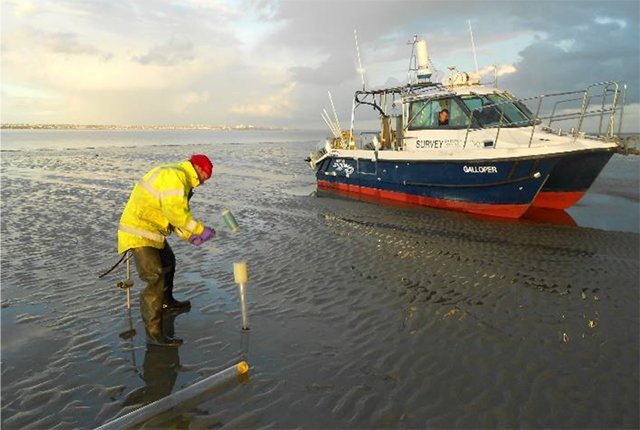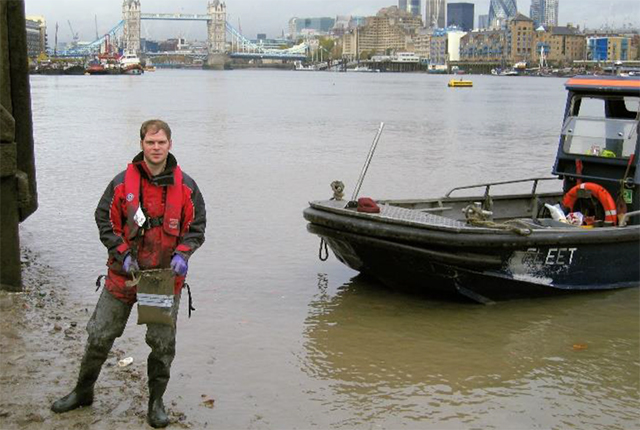London’s river islands act like a ‘sink’ for pollutants, new study finds
04/03/2020 By BGS Press
Parts of the River Thames previously thought to be relatively unaffected by Britain’s historic use of organic contaminants and metals are more polluted than first thought, according to new research.
A study of Chiswick Ait shows the sediments of the River Thames contain appreciable amounts of heavy (trace) metals that are potentially toxic to biota and humans; other river islands could be housing similar levels.
Dating of the sediments revealed that chlorinated organic contaminants such as polychlorinated biphenyls (PCBs) and toxic metals show a rise, peak and fall, which reflects the UK’s and London’s use and release from the 1950s to the 1980s.

BGS Head of Organic Chemistry, Dr Chris Vane, collects sediment samples from the River Thames.
British Geological Survey©UKRI
In what is believed to be the first ever geochemical assessment of London’s mud islands, experts from BGS studied sediment contained in the top 60 centimetres of Chiswick Ait.
The study of the ait, an uninhabited, ship-shaped island in the Borough of Hounslow, shows that tidal mud islands (aits) in the River Thames are acting like a ‘sink’ for toxic contaminants, which have been buried since the peak of the city’s industrial era in the 1950s. More frequent episodes of heavy rainfall and flooding have the potential to unlock these harmful contaminants, posing a risk to health and damaging marine biota, according to the study.
“Historic protected islands like Chiswick Ait, which is formed of clay-silt, have steadily accumulated polluted sediment and showcase a higher resolution of contaminants than some of their foreshore or channel counterparts,” explains Dr Chris Vane, Head of Organic Geochemistry at the BGS, who led the study.
“Accelerating global climate change effects may drive an increase in the intensity and frequency of flooding which mobilises buried legacy contamination and has the potential to transport it from the river back to land.
“These are pollutants which are potentially harmful to the marine environment and to humans.
“We suggest that London’s river islands are not unique in this respect and that other regularly flooded urban river islands in the UK may be acting as a similar sink for pollutants.”
The most downstream of the Thames’ river islands, Chiswick Ait is one of ten remaining medieval mud islands in the Thames. As well as featuring each year in the world-famous Oxford vs Cambridge Boat Race, it is ecologically important because it houses a variety of wildlife and trees dating back to the Middle Ages.
Despite this, it is known by scientists to deposit silt and clay sediment, as well as plastic waste, several times each month. Using collected samples, scientists were able to analyse the sediment and trace a history of contamination at the ait over about 80 years.
Sediment pollution levels are at their highest just below the surface of the water, where metal concentrations such as arsenic, lead, nickel and mercury frequently exceed sediment quality guidelines 25 to 35 centimetres from the river’s surface. Elevated concentrations of arsenic, for example, average as high as 107 milligrams per kilogram of sediment, whilst lead concentrations are reported being between 10 and 1506 milligrams per kilogram of sediment.
The team found similar patterns when looking at polychlorinated biphenyls, otherwise known as PCBs. Used in a vast range of commercial products from electrical apparatus to paints and coolants, their manufacture and use were limited in the 1980s due to growing concerns over their toxicity.
Dr Vane says: “These findings support earlier reports which suggest that levels of sediment pollution in the tidal Thames are decreasing, probably as a result of improved legislation, treatment procedures and river management. Despite this, concentrations of heavy metals vary considerably depending on depth, and at certain levels frequently exceed sediment quality guidelines.
“What we’re looking at is the ability of tidal Thames sediment to host and act as a long-term reservoir for persistent organic contaminants well above background, and this is only likely to increase with climate change pressures.”
According to the study, Chiswick Ait is predominantly subject to erosion from increased flooding between November and March and by waves caused by increased river traffic on its north-eastern bank.
The full study has been published by the Royal Society of Chemistry in Environmental Science, Process and Impacts.
Relative topics
For further details or to arrange media interviews please contact:
Hannah Pole, British Geological Survey Press Office, Keyworth, Nottingham, NG12 5GG
Office: +44 (0)115 936 3600
Mobile: +44 (0)7989 115 657
E-mail: hapo@bgs.ac.uk
Notes for Editors
- Available for telephone interview: Dr Christopher Vane, Head of Organic Geochemistry (based Keyworth, Nottingham). Can be London-based on request.
- For additional information go to: www.bgs.ac.uk
- Images: free for media use with this acknowledgement – British Geological Survey©UKRI
- The study: the full study can be requested in PDF via hapo@bgs.ac.uk
- Full title of the paper: Vane, C.H., Turner, G.H., Chenery, S.R., Richardson, M., Cave, M.C., Terrington, R., Gowing, C.J.B. and V. Moss-Hayes. 2020. Trends in Heavy Metals, Polychlorinated Biphenyls and Toxicity from Sediment Cores of the Inner Thames Estuary, London, UK. Environmental Science: Processes and Impacts 22, 364-380. DOI: 10.1039/C9EM00430K
Earlier studies
- This study follows research undertaken in 2015 which found that concentrations of the toxic metal mercury (Hg) decreased downstream from London to the outer estuary.
- Research concluded that using Hg as a generic pollution marker, the tidal Thames is one of the world’s most contaminated river–estuarine sediment systems.
- The full 2015 paper can be found here for context.
- Title of 2015 published works is here: Vane, C., Beriro, D., & Turner, G. (2015). Rise and fall of mercury (Hg) pollution in sediment cores of the Thames Estuary, London, UK. Earth and Environmental Science Transactions of the Royal Society of Edinburgh, 105(4), 285-296. doi:10.1017/S1755691015000158
British Geological Survey
The British Geological Survey (BGS) is a world leading applied geoscience research centre that is part of UK Research and Innovation (UKRI) and affiliated to the Natural Environment Research Council (NERC). BGS core science provides objective and authoritative geoscientific data, information and knowledge to inform UK Government on the opportunities and challenges of the subsurface. It undertakes national and public good research to understand earth and environmental processes in the UK and globally. The BGS annual budget of approximately £60 million pa is funded directly by UKRI, as well as research grants, government commissions and private sector contracts. Its 650 staff work across the UK with two main sites, the head office in Nottingham and Lyell Centre, a joint collaboration with Heriot Watt University in Edinburgh. BGS works with more than 150 private sector organisations, has close links to 40 universities and sponsors about 100 PhD students each year. Please see www.bgs.ac.uk.



